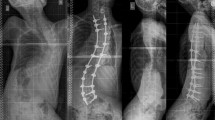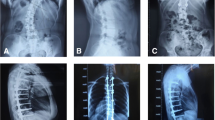Abstract
Purpose
Patients affected by cerebral palsy often develop progressive scoliosis that can results in trunk instability with an impairment of both coronal and sagittal balance. The aim of this retrospective study was to demonstrate the ability of UC to control the sagittal profile in a consecutive series of patients affected by neurological scoliosis.
Methods
From 2006 to 2008, 84 patients (57 F, 27 M) affected by neurological scoliosis were treated surgically. Mean age was 14 years (range 10–17). The etiology was mainly cerebral palsy. The average pre-operative Cobb angle was 73° ± 16°. Patients were divided into three groups according to the pre-operative presence of: physiological kyphosis (mean 29° ± 8°), thoracic lordosis (mean 10° ± 6°) and hyperkyphosis (51° ± 8°). A posterior access was performed in all patients using thoracic UC associated with transpedicular lumbar screws and a conventional claw at the upper extremity of the construct.
Results
The average percentage of coronal correction was 72%. In all three groups, we observed a common trend toward maintaining or restoring the physiological values. Mean follow-up time was 36 months. At the 1-year follow-up, the mean loss of correction was 7° ± 2° in the coronal plane and 2° ± 1° in the sagittal plane with no other change thereafter.
Conclusions
The hybrid construct using UC appears effective in neurological scoliosis treatment, providing a good correction of the deformity in both coronal and sagittal planes. In the present series, physiological thoracic kyphosis has been restored in all patients, providing better sitting tolerance in wheelchair-bound patients, and retaining standing and walking abilities in ambulatory patients.


Similar content being viewed by others
References
Winter RB, Lonstein JE, Denis F (2007) How much correction is enough? Spine 32:2641–2643
De Jonge T, Dubousset JF, Illes T (2002) Sagittal plane correction in idiopathic scoliosis. Spine 27:754–760
Kim YJ, Lenke LG, Kim J, Bridwell KH, Cho SK, Cheh G, Sides B (2006) Comparative analysis of pedicle screw versus hybrid instrumentation in posterior spinal fusion of adolescent idiopathic scoliosis. Spine 31:291–298
Vora V, Crawford A, Babekhir N, Boachie-Adjei O, Lenje L, Peskin M, Charles G, Kim Y (2007) A pedicle screw construct gives an enhanced posterior correction of adolescent idiopathic scoliosis when compared with other constructs: myth or reality. Spine 32:1869–1874
Kim YJ, Lenke LG, Cho SK, Bridwell KH, Sides B, Blanke K (2004) Comparative analysis of pedicle screw versus hook instrumentation in posterior spinal fusion of adolescent idiopathic scoliosis. Spine 29:2040–2048
Lowenstein JE, Matsumoto H, Vitale MG, Weidenbaum M, Gomez JA, Lee FY, Hyman JE, Roye DP Jr (2007) Coronal and sagittal plane correction in adolescent idiopathic scoliosis: a comparison between all pedicle screw versus hybrid thoracic hook lumbar screw constructs. Spine 32:448–452
Cheng I, Kim Y, Gupta MC, Bridwell KH, Hurford RK, Lee SS, Theerajunyaporn T, Lenke LG (2005) Apical sublaminar wires versus pedicle screws—Which provides better results for surgical correction of adolescent idiopathic scoliosis? Spine 30:2104–2112
Ilharreborde B, Even J, Lefevre Y, Fitoussi F, Presedo A, Penneçot GF, Mazda K (2010) Hybrid constructs for tridimensional correction of the thoracic spine in adolescent idiopathic scoliosis: a comparative analysis of Universal Clamps versus hooks. Spine 35:306–314
Takahata M, Ito M, Abumi K, Kotani Y, Sudo H, Ohshima S, Minami A (2007) Comparison of novel ultra-high molecular weight polyethylene tape versus conventional metal wire for sublaminar segmental fixation in the treatment of adolescent idiopathic scoliosis. J Spinal Disord Tech 20:449–455
La Rosa G, Giglio GC, Oggiano L (2011) Surgical treatment of neurological scoliosis using hybrid construct (lumbar transpedicular screws plus thoracic sublaminar acrylic loops). Eur Spine J 20(Suppl 1):S90–S94
Mazda K, Ilharreborde B, Even J, Lefevre Y, Fitoussi F, Penneçot GF (2009) Efficacy and safety of posteromedial translation for correction of thoracic curves in adolescent idiopathic scoliosis using a new correction to the spine: the Universal Clamp. Eur Spine J 18:158–169
Quan GM, Gibson MJ (2010) Correction of main thoracic adolescent idiopathic scoliosis using pedicle screw instrumentation: does higher implant density improve correction? Spine 35:562–567
Clement JL, Chau E, Kimkpe C, Vallade MJ (2008) Restoration of thoracic kyphosis by posterior instrumentation in adolescent idiopathic scoliosis: comparative radiographic analysis of two methods of reduction. Spine 33:1579–1587
De Gauzy JS, Jouve JL, Accadbled F, Blondel B, Bollini G (2011) Use of the Universal Clamp in adolescent idiopathic scoliosis for deformity correction and as an adjunct to fusion: 2-year follow-up. J Child Orthop 5:273–282
Newton PO, Yaszay B, Upasani VV, Pawelek JB, Bastrom TP, Lenke LG, Lowe T, Crawford A, Betz R, Lonner B (2010) Preservation of thoracic kyphosis is critical to maintain lumbar lordosis in the surgical treatment of adolescent idiopathic scoliosis. Spine 35:1365–1370
Vallespir GP, Flores JB, Trigueros IS, Sierra EH, Fernandez PD, Olaverri JC, Alonso MG, Galea RR, Francisco AP, Rodriguez de Paz B, Carbonell PG, Thomas JV, Lopez JL, Paulino JI, Pitarque CB, Garcia OR (2008) Vertebral coplanar alignment: a standardized technique for three dimensional correction in scoliosis surgery: technical description and preliminary results in Lenke type 1 curves. Spine 33:1588–1597
Conflict of interest
None.
Author information
Authors and Affiliations
Corresponding author
Rights and permissions
About this article
Cite this article
La Rosa, G., Giglio, G. & Oggiano, L. Sagittal profile control in patients affected by neurological scoliosis using Universal Clamps: a 4-year follow-up study. Eur Spine J 21 (Suppl 1), 32–36 (2012). https://doi.org/10.1007/s00586-012-2237-8
Received:
Accepted:
Published:
Issue Date:
DOI: https://doi.org/10.1007/s00586-012-2237-8




